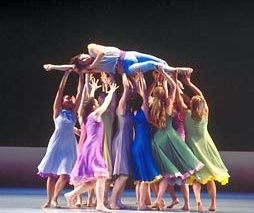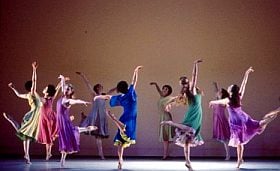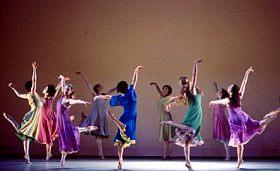
The dance is a great piece of choreography. More than that, when Morris controls the production, it becomes a great piece of art — one that embraces multiple genres and melds a musical past with a present-day theatrical sense of lightness and precision.
The basis of this work is Handel’s 1740 oratorio of the same name. The libretto, by Charles Jennens, was adapted from two separate long poems by John Milton: “L’Allegro” and “Il Penseroso, ” each being a contemplation on the advantages of being a happy person or a pensive one. The poems were cut apart and spliced together to create a discussion but not an argument — for, in the end, neither side is favored. What’s more essential to both poems is their pastoral imagery, which becomes the leaping-off point for Handel’s music along with Morris’ choreography.
For one example, Handel writes descriptive music throughout the oratorio. When l’allegro, the happy person, sings, “To hear the Lark begin his flight,/And singing startle the dull night,/From his watch-towre in the skies,/Till the dappled dawn doth rise,” the composer writes a delicate violin solo that floats and trembles. As the bird imagery continues in the poetry, a flute lifts and trills, showing Handel to be as sensitive to the bright figurings of birdcalls as Messiaen was.
Morris choreographs this passage with a rush of dancers on stage. The undulations of their arms suggest those of children imitating birds; they flock upstage, then vanish. A lone dancer in sky-blue remains center stage. He lifts his legs, one after another, knees bent and forward, like some egret, stamping. His arms lift and curve, like wings. The gestures are unabashed and pull images out of our collective memories.
Tapping Deep Wells of Emotion
It sounds preposterous, but instead it delights. The choreography taps into both the deep human desire
The movement also works because of the dancers’ commitment and the precision of their technique. Other creatures weave throughout the piece, too: dancers on all fours scrabble across the stage like hounds; foxes flit and giggle through ancient oaks composed of twisting dancers’ bodies; horses prance.
These narrative gestures are placed onto a stage outfitted with the most abstract and minimal of sets. Several enormous white frames outline the stage’s dimensions, having been placed at intervals ranging from the proscenium downstage to the upstage area. They serve as window frames behind which are transparent, colored scrims. The scrims move up and down during the choreography, dividing the action into a series of vignettes. The colors change from red to black, blue to gold, configuring the pastoral filigree of L’Allegro, il penseroso, ed il moderato into an abstract painting banded in lucent color.
During the lark’s solo, the single upstage scrim is, like the dancer’s costume, a pale sky-blue. Immediately after his solo, two women come forth, to continue the dance of birds: a soprano, il penseroso, sings, “Sweet Bird that shunn’st the noise of folly,/Most musicall, most melancholy!/Thee Chauntress oft the Woods among,/I woo to hear thy Even-Song.” Several whitish scrims drop to divide the stage front to back, and the two women dancers are separated, the one upstage appearing as a pale reflection of the other, as if she were the other’s image in a cloudy mirror. The effect moves the duet into the realm of time, as well as space. The pale shadowings of the upstage dancer seem to exist in a different space and a distant time.
David Leventhal danced the solo bluebird of happiness, and Julie Worden danced the pensive bird, with Lauren Grant as her otherworldly twin.
All Grist for the Morris Mill
Every morning Mark Morris leads company class, and it’s a ballet class. But that is not to say that his choreography is ballet or that his dancers are ballet dancers. As L’Allegro, il penseroso, ed il moderato shows, every kind of movement — from ballet to folk dance to walking and running — is food for this choreographer’s imagination. His dancers, too, come from all kinds of movement backgrounds, and only two things are required of them: consummate technique as a dancer, and a precise sense of musicality. Those skills allow them to perform Morris’ choreography by making the wide variety of skilled movement appear completely effortless within the context of the music.Morris insists on live music, and his dancers were accompanied by the fine Philharmonia Baroque Orchestra performing, thankfully, on original instruments and directed by Jane Glover. Likewise, the soloists were everything one could hope for: sopranos Christine Brandes and Lisa Saffer, tenor Iain Paton, and baritone James Maddalena.
The Chamber Chorus of the University of California, directed by Marika Kuzma, completed the circle of magic.

